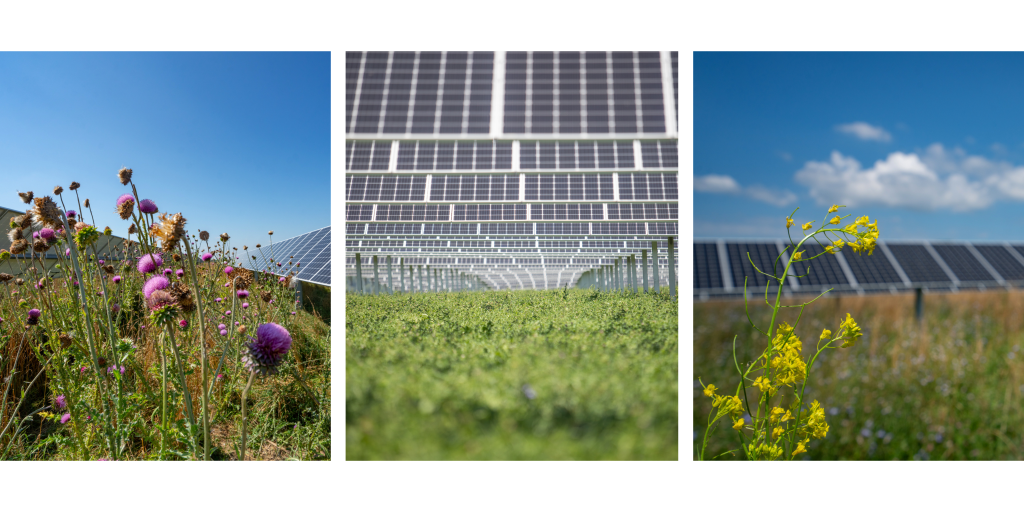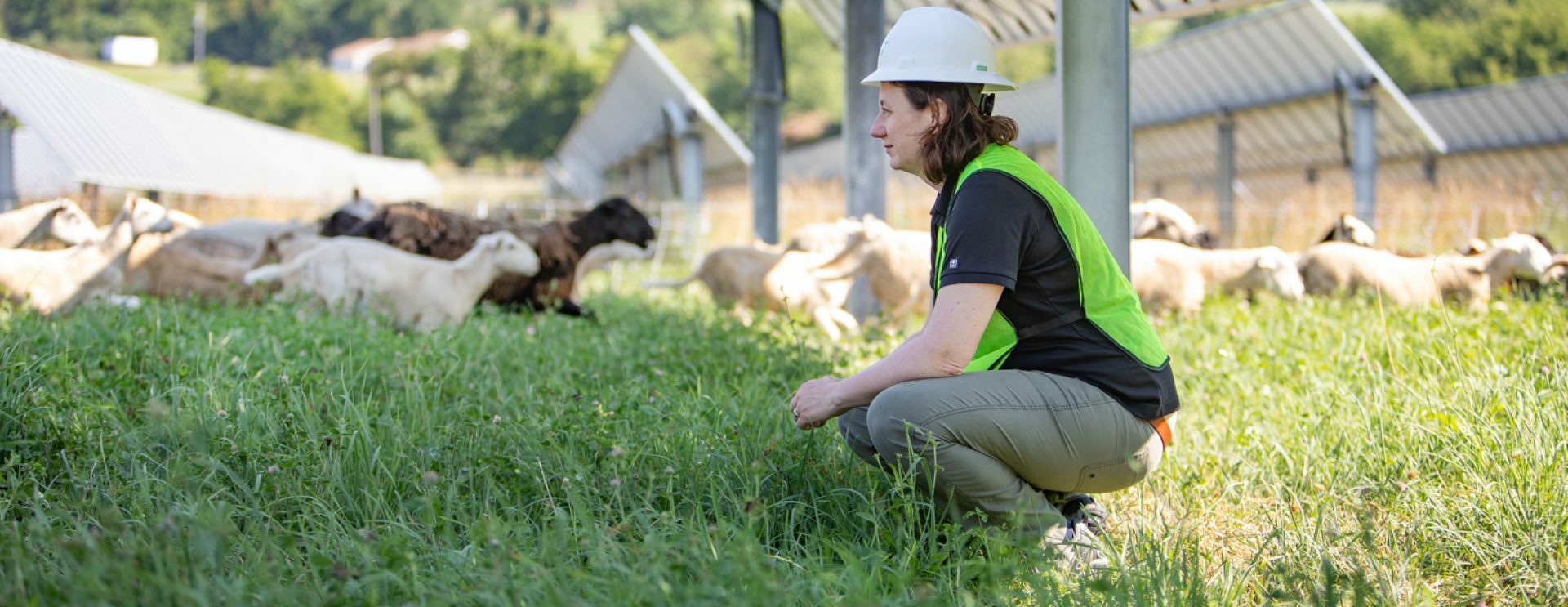Solar farm, living laboratory: Lightsource bp’s Nittany Solar projects in Pennsylvania
A solar farm can be a living, breathing ecosystem complete with soil microbes, vegetation, insects, wildlife and, in some cases, domesticated livestock. Solar developers, landowners, and scholars want to learn more about the ecology and economics of these sites so they can determine best practices for maximizing the sustainable benefits of solar.
In recent years, the environmental management of solar farms has become an exciting area of academic research, to assess how different practices affect the productivity of solar and agricultural enterprises and the land on which they operate. Two studies seeking to answer research questions around these topics are currently underway at Lightsource bp’s Nittany 1, 2 and 3 solar projects in Pennsylvania.
The projects, totaling 70MW altogether, are operational in Franklin County. They are powering 25% of Penn State University’s state-wide electricity needs under a 25-year power purchase agreement.
All three sites were designed and are being actively managed to boost biodiversity and support pollinator populations, in addition to generating clean energy for Penn State and their students. Lightsource bp seeded the sites with a mix specifically formulated by the American Solar Grazing Association (ASGA), in partnership with Ernst Conservation Seeds and Pollinator Service. The seed mix, aptly named “Fuzz and Buzz,” was designed to support pollinator species at solar sites, in addition to flocks of sheep.
At Nittany 1, more than 700 sheep are managing vegetation through rotational grazing, an example of agrivoltaics, or co-located solar and agriculture.
Keep reading to learn more about the exciting research projects taking place at these sites.

Shippensburg University: How do solar farms affect soil?
Every ecosystem—solar farms included—starts with the soil. Researchers from the Shippensburg University Geography & Earth Science Department are conducting research at Nittany 1, 2 and 3 to learn how converting farmland to solar fields affects soil properties, carbon dynamics and biodiversity.
Dr. Russell Hedberg and Dr. Claire Jantz are leading the inquiry into the nexus of ecosystem services, future food production, and renewable energy needs. Their study asks three questions.
- How does conversion to solar impact soil carbon dynamics, which are the foundation of soil food webs and critical to meeting carbon sequestration goals?
- How does solar conversion affect the abundance of soil macroinvertibrates, which link soil food webs to the broader terrestrial food web?
- How does conversion to solar affect soil physical properties, which support nutrient retention, plant biodiversity, and sustainable hydrology?
The research team has mapped soil type, slope and variation across all three sites using the USDA-NRCS gridded Soil Survey Geographic Database. To assess soil health, researchers will collect data in the field as well, measuring organic carbon, the abundance of soil-dwelling organisms, soil stability and soil compaction in collected samples.
Funding from the Renewable Energy Wildlife Institute (REWI) is supporting this project.

ASGA and NYSERDA: What are the agro-economic and environmental impacts of co-location of solar and agriculture?
We know that co-locating sheep on solar farms is a win-win-win for grazers, developers and the planet, but how do we measure the impacts? Our long-time partners at the American Solar Grazing Association (ASGA) are conducting a two-year study at more than 30 operational solar grazing sites across the Northeastern US, including at Lightsource bp’s Nittany 1 project. The study, sponsored by the New York State Energy Research and Development Authority (NYSERDA), is examining both the environmental and economic impacts of sheep grazing on solar farms, a prevalent form of agrivoltaics.
As sheep graze, they trample manure, urine, seeds and plant matter into the earth. The plant matter decomposes, and together with the animal waste, it fertilizes and rejuvenates the soil. To measure these impacts, the researchers will look at soil carbon, nutrients, moisture, and compaction before and after the 2021 and 2022 grazing seasons.
Researchers will additionally assess on-site vegetation, gathering information on seed mix applications, collecting samples and using the U.S. Department of Agriculture Guide to Pasture Condition Scoring to rate performance. As healthy pasture is essential for successful sheep grazing, our Nittany 1 project has been planted with a special seed mix called “Fuzz and Buzz,” carefully designed to support both livestock nutrition and nectar resources for pollinators in Pennsylvania. This study will be the first to use the USDA guide and scorecard on solar planting mixes.
Understanding the business side of solar grazing is just as critical as studying environmental impacts. Lightsource bp’s grazing partners can count on regular payments for their services through grazing contracts This gives farmers a reliable source of new income, on top of what they earn via the meat, dairy and wool they produce.
Researchers will perform economic analyses to examine the viability of these enterprises for farmers and solar companies alike. This will include surveying both groups to learn more about cost, labor, risk and income, compared to traditional vegetation management methods.
Discover Multiuse Solar
Our Nittany Solar projects are an example of our commitment to co-locating responsibly sited solar projects with other land uses in the United States—an approach dubbed “dual-use solar.” Lightsource bp often goes a step further, building multiuse solar projects where clean energy generation shares land with multiple initiatives including agriculture, conservation, and research. Click below for further information.
Related news
26 Jun, 2025
Lightsource bp signs first PPA in Taiwan with Star Trade for pilot fishery solar project
Lightsource bp has signed a power purchase agreement (PPA) with Star Trade for its Budai solar project in Taiwan.
10 Jun, 2025
Lightsource bp secures financing on its first project in Taiwan and its pilot fishery solar project globally
Lightsource bp, a leading developer and manager of global onshore renewable energy projects, has secured financing for its 115MWp fishery solar project in Taiwan.
05 Jun, 2025
PPAs: a key lever for the energy transition in Europe
Watch our webinar to learn about how sustainable PPAs are emerging as a key commercial solution for corporate buyers.




